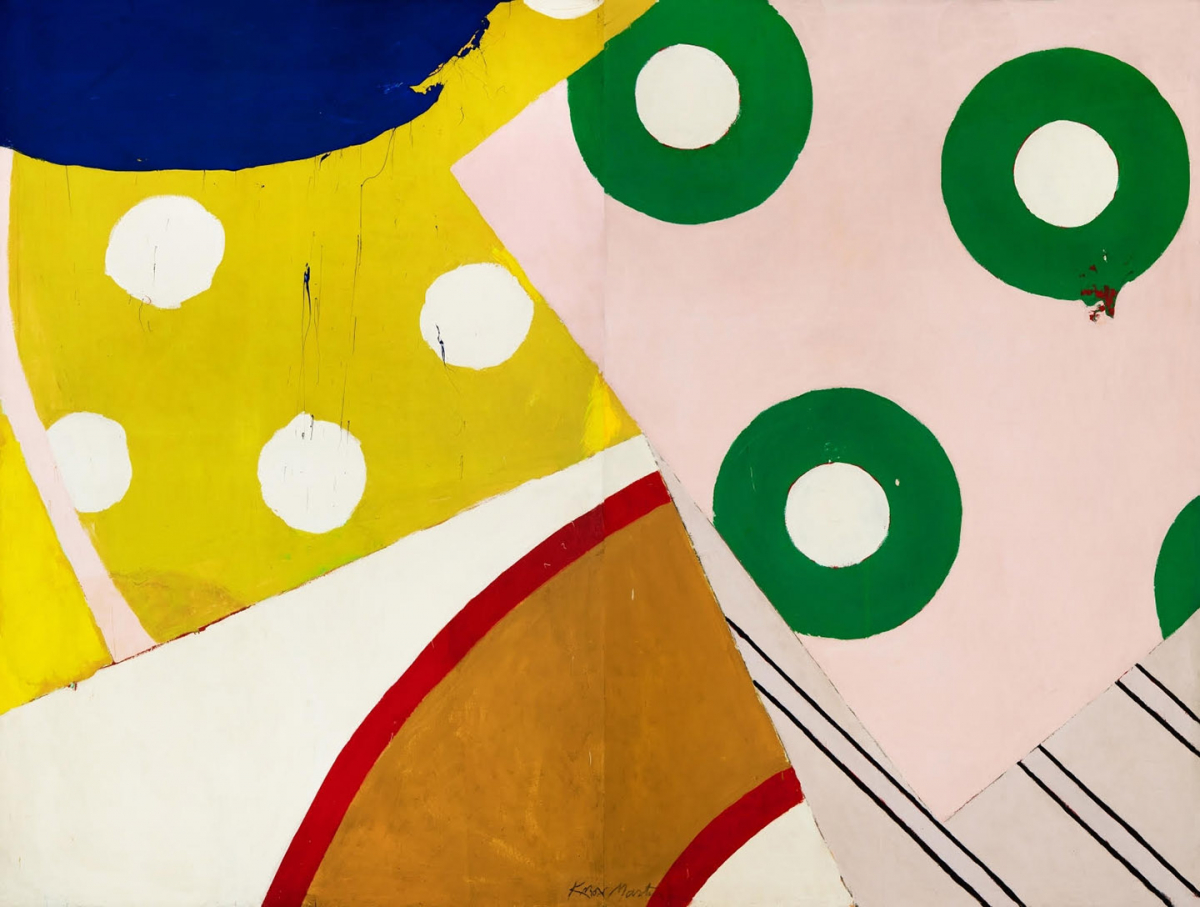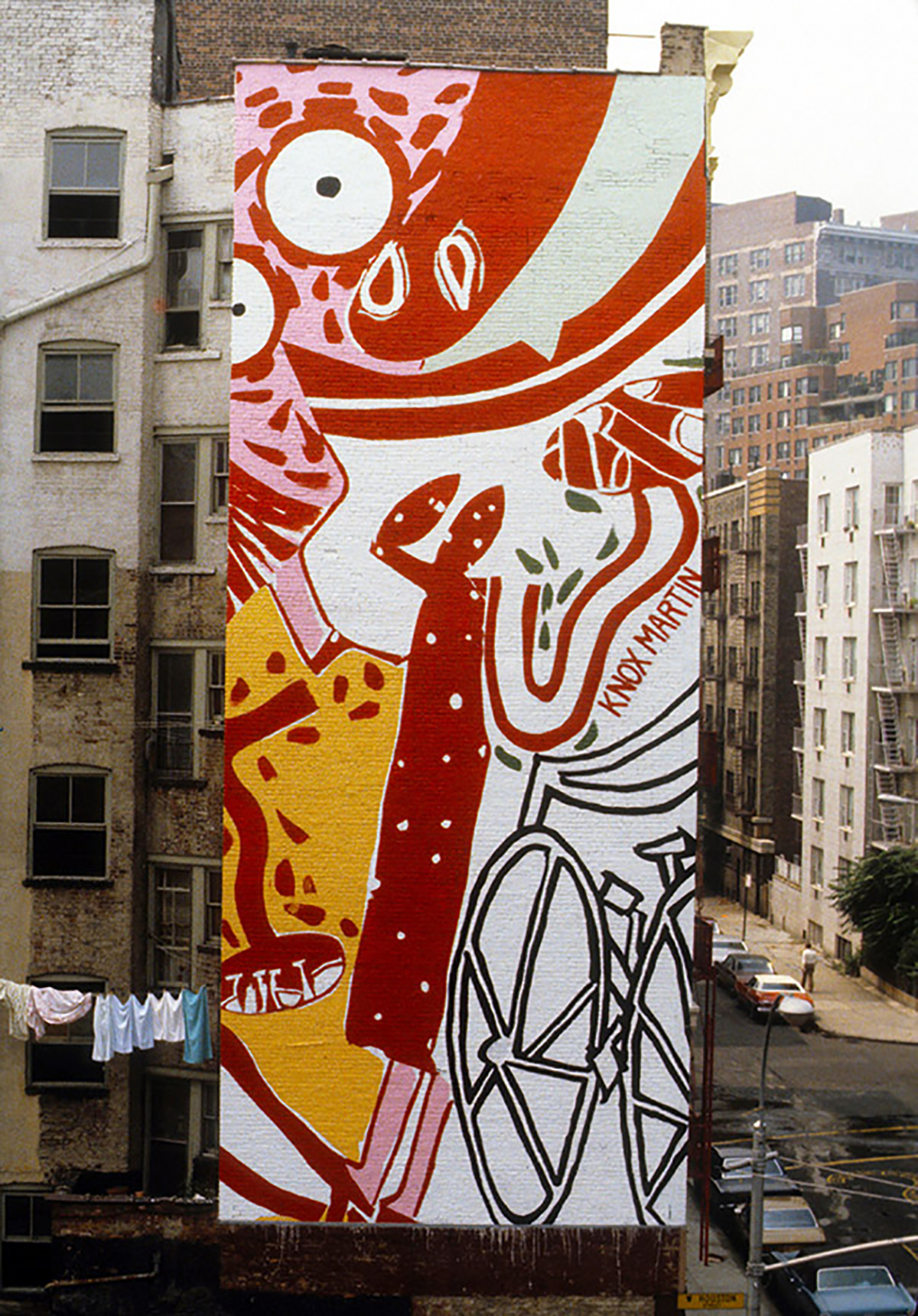A conversation between George Lloyd and John Paul, (MFA Yale 1969) Concerning Knox Martin's show at Hollis Taggart Gallery, June 3, 2019.
John Paul: When Gabriela Ryan asked me to write something about Knox's recent show at Hollis Taggart Gallery, I was watching a tv program about Buffalo Bill Cody and Annie Oakley. I let the picture run through our conversation, fascinated by the timeline of the legendary frontier showman and his shooting starlet. I felt no distracting contradiction. For us, the life and times of Cody are less legendary than the era of our painting heroes -- those decades in an emptier and less crowded New York when DeKooning, Gorky, Kline, Ilya Bolotowsky and Knox Martin were staking a claim for a viable language in painting. We can add many others -- fanning out into New England and Maine. Will Barnet, Jack Tworkov, Hans Hoffman, even Provincetown's Edwin Dickinson. Knox’s involvement in the New York School of painting is well documented. He was friends with DeKooning and Kline (although not with Gorky personally). Knox was also happy to know his Washington Heights neighbor Elias Goldberg (AKA the Pissarro of Washington Heights) and is deeply moved by these physically modest works in oil and watercolor -- in ways that derive from Cezanne. Knox has no prejudice about size in art.
George Llyod: I write at a disadvantage, unable to view these pictures in person. Nevertheless, I'll do my best based on the exhibit catalog and images available online.
JP: You are the right person to handle the challenge. There aren't many others in our class who kept up drawing in structures as you have. You also inherited a deep respect for architecture and concept drawing from your father. To continue, the show at Hollis Taggart is aptly titled Radical Structures. The analysis and underlying geometry in art is a Knox Martin phenomenon. No one else was discussing art on this level, or working on it openly.
GL: That's right. In our drawing class Knox would take out a big reproduction of a Franz Hals and trace the linear structure. Some of the students would doze off, but for me it was an eye-opener.
JP: Just recently, Knox, his daughter Olivia, and another friend, were at the Met Breuer for the show "Unfinished." There was an El Greco and other old masters, but the big occasion was Titian's "The Flaying Of Marsyas." Knox took out his laser pen light and rapidly traced for us, the subtle underlying geometry, the circulating activation of form.
Given that the viewer's need to wander and be directed, Titian knew how to create an experience using the myth as a point of departure. The act of composition can bring an acute and sometimes unnerving realization on other levels of perception, on the empathy level. Anyway, Knox's clear and unrestrained voice, and the light pen tracings on the sixteenth century surface, created havoc in the museum. Guards and eventually the head curator had to shut down this wonderful moment -- but it was too late: the mission was already accomplished.
GL: The impression I have from Rubber Soul [diptych 1963] is one of bright and buoyant forms, gliding effortlessly across the viewer's field of vision. The effect is analogous to that of a summer's day, or maybe that of a day dream in fortuitous conjunction with delectable sensations of color and surface. In contrast to some of his more Minimalist contemporaries who applied paint to canvas in a more mechanical and less nuanced fashion, Knox does not shirk from indulgence in the more sensual possibilities inherent in the paint medium. So while on one level, Knox may seem to pull out all the stops, on another he works within a very limited set of strictures, employing classic oppositions like arcs and straight lines, circles and squares .
JP: There are these tilted and interrupted patterns of dots, that intersect, compete for the foreground then recede to an unseen periphery. He references Islamic and Persian art -- and pattern that predates by centuries the Op Art of the sixties.

GL: I would be remiss not to reference the critical role of movement and gesture in these pictures. In She [1963-5 ], a sense of high drama is provoked by the playful actions of shapes and forms upon each other in a matrix of shallow depth. Historical antecedent here would be early 20th century Synthetic Cubist collage. Another essential component of Knox's painting process might well be referred to as "Body English." In this way, the presence of the "Hero Shape Shifter" that Knox would frequently refer to in his classroom lectures in New Haven is never far away. For Knox, it would seem that a sense of the lurking presence of the man who made them would be critical to the effect of his pictures upon the viewer who encounters them.
JP: The sense of affirmation, exploded by DeKooning and Picasso, and the concealment power of Matisse (alive and kicking in those days, but in very different ways) is inescapable. Let's not forget that the painter as well as the painting in this show had an extraordinary physicality and confidence. Then Knox was doing many things of personal interest: martial arts, sculpture, magic, dagger throwing, and piloting a small plane. Artist friends would talk of his exploits, but that was beside the point. He was his own man in art. Seeing these paintings in a retrospective show, from his and our youth, revives those memories. And he is still making powerful things happen on the canvas.
GL: The years just after World War 2, when Knox studied at the League with Will Barnet, would have coincided with Will's Indian Space period. Not a big stretch to find a parallel between the flat patterned surfaces of Will's Indian Space pictures and the kind of surface arabesques which are so characteristic of Knox .
JP: I'm glad you mentioned the shape-juxtaposing clarity of Barnet. Will spoke about the excitement of designing a plan for the painting to contain itself, to reinforce the picture narrative with an underlying structure. Not just an expedient, but a solution to a puzzle, a personal icon perhaps. Not letting everything drift or leak out the edges.
BL: It would also be relevant to note that Will Barnet, who was born near to Boston in 1911, was a lifelong admirer of the great mural cycle by Puvis de Chavannes which had been installed in the grand staircase of the Boston Public Library just a decade or so prior to Will's birth. In Barnet's opinion, which I had directly from him, Puvis was a proto-Modern. According to Will, the French muralist's deep respect for the wall surfaces which his paintings occupied was directly related to Modernist notions about flatness and the integrity of the picture surface.
That Puvis was a Symbolist and a painter of dreams might well serve to open up another path not only to Barnet's Indian Space pictures but also to Knox, who was never one to refrain from poetic allusion in his painting. Modernist concerns for material values and a consequent reverence for the painting as a physical object in and of itself did not, for Knox, ever present a barrier to dreaming. Even in a painting as ostensibly reduced to abstraction as SHE, it is the female figure which is found to be the pivot of inspiration for the artist in question.
JP: In this show the elegant weights and balances of the paint bodies remind us of his physical daring and audacity. But getting back to Yale in the sixties -- looking back on Knox's drawing class, when we were students, Knox was more than a responsible teacher: he was a lightning rod of empowerment. His drawing classes in the Yale program were listed in the curriculum with action-inspiring titles: Super Creator 1 and 2. We were learning to find ways to achieve "activation." Drawing needed to be tensed and interactive in its parts like a perpetual motion machine. I know I simplify, and axioms are useless without demonstration. But without Knox in my history, much of the excellent education I had in art academies would fade, or worse, stumble in repetition of a format. His knowledge of art history, literature, philosophy, religions, astronomy and the natural universe sustained our encounters with the blank page, the empty white canvas.
GL: And for Knox it could be a white page of paper or a city wall! The same thing.

JP: Yes, Knox also painted major public murals. I especially marvelled at the Venus mural on West Street and the Woman With Bicycle (above) on Houston Street. They were fixtures of my adopted city. I would look up at these on a daily basis. In recent years we have discussed murals, when I was licensed to paint outdoor ads and murals. He told me those walls existed for him as works in themselves: not as publicity to promote his status in the art world. Richard Haas, the architect, made many forgettable outdoor walls. They were academic. Knox's walls were fun and came out of a virile sense of humor. I miss seeing them up there.

Great read!